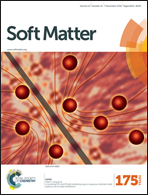Merging fluid and solid granular behavior†
Abstract
Simple homogeneous shear flows of frictionless, deformable particles are studied by particle simulations at large shear rates and for differently soft, deformable particles. Particle stiffness sets a time-scale that can be used to scale the physical quantities; thus the dimensionless shear rate, i.e. the inertial number I (inversely proportional to pressure), can alternatively be expressed as inversely proportional to the square root of particle stiffness. Asymptotic scaling relations for the field variables pressure, shear stress and granular temperature are inferred from simulations in both fluid and solid regimes, corresponding to unjammed and jammed conditions. Then the limit cases are merged to unique constitutive relations that cover also the transition zone in the proximity of jamming. By exploiting the diverging behavior of the scaling laws at the jamming density, we arrive at continuous and differentiable phenomenological constitutive relations for stresses and granular temperature as functions of the volume fraction, shear rate, particle stiffness and distance from jamming. In contrast to steady shear flows of hard particles the (shear) stress ratio μ does not collapse as a function of the inertial number, indicating the need for an additional control parameter. In the range of particle stiffnesses investigated, in the solid regime, only pressure is rate independent, whereas shear stress exhibits a slight shear rate- and stiffness-dependency.



 Please wait while we load your content...
Please wait while we load your content...